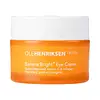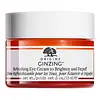What's inside
What's inside
 Key Ingredients
Key Ingredients

 Benefits
Benefits

 Concerns
Concerns

 Ingredients Side-by-side
Ingredients Side-by-side

Water
Skin ConditioningSimmondsia Chinensis Seed Oil
EmollientButyrospermum Parkii Butter
Skin ConditioningIsododecane
EmollientCoconut Alkanes
Emollient3-O-Ethyl Ascorbic Acid
Skin ConditioningCetearyl Alcohol
EmollientGlycerin
HumectantC18-38 Alkyl Hydroxystearoyl Stearate
EmollientDilinoleic Acid/Propanediol Copolymer
EmollientPolymethylsilsesquioxane
Cocoyl Proline
Skin ConditioningDimethicone Crosspolymer
Emulsion StabilisingPentaerythrityl Tetraisostearate
EmollientTetrahexyldecyl Ascorbate
AntioxidantAscorbic Acid
AntioxidantGold
Cosmetic ColorantGlutathione
Citrus Nobilis Fruit Extract
MaskingCitrus Paradisi Peel Extract
PerfumingGlucosyl Hesperidin
HumectantTocopherol
AntioxidantTamarindus Indica Seed Polysaccharide
Skin ConditioningPoncirus Trifoliata Fruit Extract
Skin ConditioningMorus Alba Root Extract
BleachingLinoleic Acid
CleansingLinolenic Acid
CleansingJojoba Esters
EmollientCaprylyl Glycol
EmollientCoco-Caprylate/Caprate
EmollientPropanediol
SolventPolyglyceryl-3 Cocoate
EmulsifyingPolyglyceryl-4 Caprate
EmulsifyingPolyglyceryl-6 Caprylate
EmulsifyingPolyglyceryl-6 Ricinoleate
EmulsifyingHdi/Trimethylol Hexyllactone Crosspolymer
Polyacrylate-13
Butylene Glycol
HumectantPolyglyceryl-3 Stearate
EmulsifyingPolysorbate 20
EmulsifyingSodium Citrate
BufferingPolyisobutene
Beheneth-5
EmulsifyingAcrylates/C10-30 Alkyl Acrylate Crosspolymer
Emulsion StabilisingBehenyl Alcohol
EmollientSodium Hydroxide
BufferingSorbic Acid
PreservativeSorbitan Isostearate
EmulsifyingCitric Acid
BufferingHydrolyzed Vegetable Protein
Skin ConditioningStearic Acid
CleansingPalmitic Acid
EmollientOleic Acid
EmollientSorbitol
HumectantSilica
AbrasiveSodium Benzoate
Masking1,2-Hexanediol
Skin ConditioningXanthan Gum
EmulsifyingPhenoxyethanol
PreservativeLeuconostoc/Radish Root Ferment Filtrate
AntimicrobialMica
Cosmetic ColorantTitanium Dioxide
Cosmetic ColorantCI 77891
Cosmetic ColorantCI 77491
Cosmetic ColorantWater, Simmondsia Chinensis Seed Oil, Butyrospermum Parkii Butter, Isododecane, Coconut Alkanes, 3-O-Ethyl Ascorbic Acid, Cetearyl Alcohol, Glycerin, C18-38 Alkyl Hydroxystearoyl Stearate, Dilinoleic Acid/Propanediol Copolymer, Polymethylsilsesquioxane, Cocoyl Proline, Dimethicone Crosspolymer, Pentaerythrityl Tetraisostearate, Tetrahexyldecyl Ascorbate, Ascorbic Acid, Gold, Glutathione, Citrus Nobilis Fruit Extract, Citrus Paradisi Peel Extract, Glucosyl Hesperidin, Tocopherol, Tamarindus Indica Seed Polysaccharide, Poncirus Trifoliata Fruit Extract, Morus Alba Root Extract, Linoleic Acid, Linolenic Acid, Jojoba Esters, Caprylyl Glycol, Coco-Caprylate/Caprate, Propanediol, Polyglyceryl-3 Cocoate, Polyglyceryl-4 Caprate, Polyglyceryl-6 Caprylate, Polyglyceryl-6 Ricinoleate, Hdi/Trimethylol Hexyllactone Crosspolymer, Polyacrylate-13, Butylene Glycol, Polyglyceryl-3 Stearate, Polysorbate 20, Sodium Citrate, Polyisobutene, Beheneth-5, Acrylates/C10-30 Alkyl Acrylate Crosspolymer, Behenyl Alcohol, Sodium Hydroxide, Sorbic Acid, Sorbitan Isostearate, Citric Acid, Hydrolyzed Vegetable Protein, Stearic Acid, Palmitic Acid, Oleic Acid, Sorbitol, Silica, Sodium Benzoate, 1,2-Hexanediol, Xanthan Gum, Phenoxyethanol, Leuconostoc/Radish Root Ferment Filtrate, Mica, Titanium Dioxide, CI 77891, CI 77491
Water
Skin ConditioningMethyl Trimethicone
Skin ConditioningButylene Glycol
HumectantPEG-100 Stearate
Dimethicone
EmollientCetyl Ricinoleate
EmollientSilica
AbrasiveOlea Europaea Fruit Oil
MaskingGlycerin
HumectantBehenyl Alcohol
EmollientCucumis Sativus Fruit Extract
EmollientPanax Ginseng Root Extract
EmollientCastanea Sativa Seed Extract
Skin ConditioningCamellia Sinensis Leaf Extract
AntimicrobialCordyceps Sinensis Extract
AntioxidantMagnolia Officinalis Bark Extract
AntimicrobialPyrus Malus Fruit Extract
Skin ConditioningScutellaria Baicalensis Root Extract
AstringentPantethine
EmollientPanthenol
Skin ConditioningCaprylic/Capric Triglyceride
MaskingButyrospermum Parkii Butter
Skin ConditioningCaffeine
Skin ConditioningUsnea Barbata Extract
Yeast Extract
Skin ConditioningFolic Acid
Skin ConditioningHydrogenated Lecithin
EmulsifyingJojoba Wax PEG-120 Esters
Biotin
AntiseborrhoeicTribehenin
EmollientMyristyl Alcohol
EmollientPalmitoyl Tetrapeptide-7
Skin ConditioningTrehalose
HumectantSodium Hyaluronate
HumectantAscorbyl Tocopheryl Maleate
AntioxidantHesperidin Methyl Chalcone
AntioxidantSodium Sulfite
PreservativeSodium Metabisulfite
AntioxidantSteareth-20
CleansingDipeptide-2
Skin ConditioningEthylhexylglycerin
Skin ConditioningCarbomer
Emulsion StabilisingTromethamine
BufferingSorbic Acid
PreservativeChlorphenesin
AntimicrobialPhenoxyethanol
PreservativeMica
Cosmetic ColorantCI 77891
Cosmetic ColorantIron Oxides
Water, Methyl Trimethicone, Butylene Glycol, PEG-100 Stearate, Dimethicone, Cetyl Ricinoleate, Silica, Olea Europaea Fruit Oil, Glycerin, Behenyl Alcohol, Cucumis Sativus Fruit Extract, Panax Ginseng Root Extract, Castanea Sativa Seed Extract, Camellia Sinensis Leaf Extract, Cordyceps Sinensis Extract, Magnolia Officinalis Bark Extract, Pyrus Malus Fruit Extract, Scutellaria Baicalensis Root Extract, Pantethine, Panthenol, Caprylic/Capric Triglyceride, Butyrospermum Parkii Butter, Caffeine, Usnea Barbata Extract, Yeast Extract, Folic Acid, Hydrogenated Lecithin, Jojoba Wax PEG-120 Esters, Biotin, Tribehenin, Myristyl Alcohol, Palmitoyl Tetrapeptide-7, Trehalose, Sodium Hyaluronate, Ascorbyl Tocopheryl Maleate, Hesperidin Methyl Chalcone, Sodium Sulfite, Sodium Metabisulfite, Steareth-20, Dipeptide-2, Ethylhexylglycerin, Carbomer, Tromethamine, Sorbic Acid, Chlorphenesin, Phenoxyethanol, Mica, CI 77891, Iron Oxides
 Reviews
Reviews

Ingredients Explained
These ingredients are found in both products.
Ingredients higher up in an ingredient list are typically present in a larger amount.
Behenyl Alcohol is a type of fatty alcohol (these are different from the drying, solvent alcohols).
Fatty Alcohols have hydrating properties and are most often used as an emollient or to thicken a product. They are usually derived from natural fats and oils; behenyl alcohol is derived from the fats of vegetable oils.
Emollients help keep your skin soft and hydrated by creating a film that traps moisture in.
In 2000, Behenyl Alcohol was approved by the US as medicine to reduce the duration of cold sores.
Learn more about Behenyl AlcoholButylene Glycol (or BG) is used within cosmetic products for a few different reasons:
Overall, Butylene Glycol is a safe and well-rounded ingredient that works well with other ingredients.
Though this ingredient works well with most skin types, some people with sensitive skin may experience a reaction such as allergic rashes, closed comedones, or itchiness.
Learn more about Butylene GlycolThis ingredient is also known as shea butter. It is an effective skin hydrator and emollient.
Emollients help soothe and soften your skin. It does this by creating a protective film on your skin. This barrier helps trap moisture and keeps your skin hydrated. Emollients may be effective at treating dry or itchy skin.
Shea butter is rich in antioxidants. Antioxidants help fight free-radicals, or molecules that may harm the body. It is also full of fatty acids including stearic acid and linoleic acid. These acids help replenish the skin and keep skin moisturized.
While Shea Butter has an SPF rating of about 3-4, it is not a sunscreen replacement.
Shea butter may not be fungal acne safe. We recommend speaking with a professional if you have any concerns.
Learn more about Butyrospermum Parkii ButterCi 77891 is a white pigment from Titanium dioxide. It is naturally found in minerals such as rutile and ilmenite.
It's main function is to add a white color to cosmetics. It can also be mixed with other colors to create different shades.
Ci 77891 is commonly found in sunscreens due to its ability to block UV rays.
Learn more about CI 77891Glycerin is already naturally found in your skin. It helps moisturize and protect your skin.
A study from 2016 found glycerin to be more effective as a humectant than AHAs and hyaluronic acid.
As a humectant, it helps the skin stay hydrated by pulling moisture to your skin. The low molecular weight of glycerin allows it to pull moisture into the deeper layers of your skin.
Hydrated skin improves your skin barrier; Your skin barrier helps protect against irritants and bacteria.
Glycerin has also been found to have antimicrobial and antiviral properties. Due to these properties, glycerin is often used in wound and burn treatments.
In cosmetics, glycerin is usually derived from plants such as soybean or palm. However, it can also be sourced from animals, such as tallow or animal fat.
This ingredient is organic, colorless, odorless, and non-toxic.
Glycerin is the name for this ingredient in American English. British English uses Glycerol/Glycerine.
Learn more about GlycerinMica is a naturally occurring mineral used to add shimmer and color in cosmetics. It can also help improve the texture of a product or give it an opaque, white/silver color.
Serecite is the name for very fine but ragged grains of mica.
This ingredient is often coated with metal oxides like titanium dioxide. Trace amounts of heavy metals may be found in mica, but these metals are not harmful in our personal products.
Mica has been used since prehistoric times throughout the world. Ancient Egyptian, Indian, Greek, Roman, Aztec, and Chinese civilizations have used mica.
Learn more about MicaPhenoxyethanol is a preservative that has germicide, antimicrobial, and aromatic properties. Studies show that phenoxyethanol can prevent microbial growth. By itself, it has a scent that is similar to that of a rose.
It's often used in formulations along with Caprylyl Glycol to preserve the shelf life of products.
Silica, also known as silicon dioxide, is a naturally occurring mineral. It is used as a fine, spherical, and porous powder in cosmetics.
Though it has exfoliant properties, the function of silica varies depending on the product.
The unique structure of silica enhances the spreadability and adds smoothness, making it a great texture enhancer.
It is also used as an active carrier, emulsifier, and mattifier due to its ability to absorb excess oil.
In some products, tiny microneedles called spicules are made from silica or hydrolyzed sponge. When you rub them in, they lightly polish away dead skin layers and enhance the penetration of active ingredients.
Learn more about SilicaSorbic Acid is a preservative. It is the most commonly used food preservative in the world.
Sorbic Acid is a natural antibiotic and highly effective at preventing the growth of fungus. It is less effective against bacteria.
Potassium Sorbate, another commonly-used preservative, is the potassium salt of Sorbic Acid.
Sorbic Acid may worsen eczema. We recommend speaking with a professional if you have any concerns.
Potassium sorbate and sorbic acid can be found in baked goods, cheeses, dried meats, dried fruit, ice cream, pickles, wine, yogurt, and more.
Learn more about Sorbic AcidWater. It's the most common cosmetic ingredient of all. You'll usually see it at the top of ingredient lists, meaning that it makes up the largest part of the product.
So why is it so popular? Water most often acts as a solvent - this means that it helps dissolve other ingredients into the formulation.
You'll also recognize water as that liquid we all need to stay alive. If you see this, drink a glass of water. Stay hydrated!
Learn more about Water